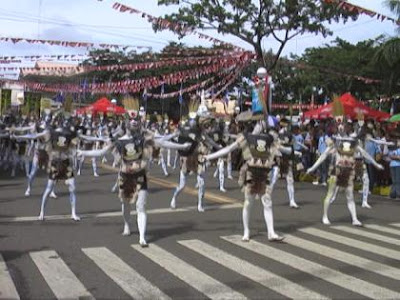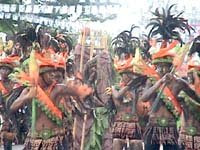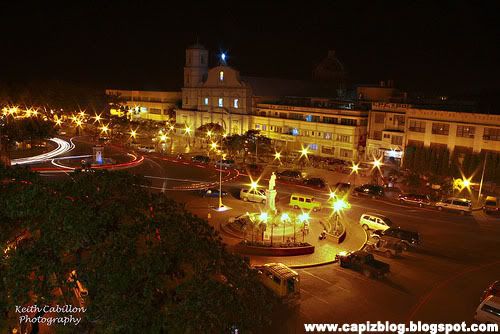What so special with "Captivating Capiz" is its festivals. Every year the province of Capiz celebrates the Sinadya sa Halaran, a festival that usually happens in December. They also have this food festival called "Diwal Festival".
From the history of Capiz, this festival commerates the rich culture and tradition of the captivating place. Colorful parade and fascinating fireworks are some of the highlights of this event. This year Capiz will celebrate their festivities with, "We are sure", another "big bang!"
The Many Colors of Capiz
MUCH celebrated as the “Seafood Capital of Philippines,” Roxas City, as well as Capiz, has truly metamorphosed from being typecast as aswang haven to one of the road maps of tourists whenever they com e to the Philippines.
e to the Philippines.
Rich in culture, steep in tradition and blessed with the bounties of nature, Capiz is home to festivals that have caught the eyes of the country as well as the whole world.
SINADYA SA HALARAN
An infusion of two of the province’s biggest festivals, Sinadya sa Halaran is an artistic and cultural pageantry as well as a religious celebration held every first week of December.
Literally known as “joy in giving and thanksgiving,” Sinadya sa Halaran was originally celebrated separately. Sinadya was a festival celebrated every December in Roxas City in honor of its patron saint, the Immaculate Conception. Among the famous activities during this celebration were displays of rituals and festivities originally Capiceño, including fireworks display, parade of giant paper images, fairs and food exhibits, as well as dance contests.
On the other hands, the Halaran festival, which was celebrated every first week of October, showcased the history of Capiz from the landing of the Bornean datus on the shores of Panay. Halaran, which came from the Visayan word halad, means gift or offer. This came from the legend of the Bornean datus’ gift of golden salakot to the native aborigines’ chief. This resulted to festivity and celebration which was offered by the natives to the deities.
In 1997, these two festivals were fused together and since then, it became grander than ever. According to Bryan Mari Argos, “the parade of festivals is a testimony of how rich Capiznon culture is.” This richness is clearly exhibited in the people’s love for merrymaking and enjoyment.
During this December festival, color and excitement flows everywhere in Roxas City. A solemn procession on the river, fireworks display, and trade fairs were held aside from the street performances staged by the different municipalities of the province.
The seafood-themed tribal competition held in the city plaza is also a breathtaking event that adds up to the excitement of the festival.
But the most opulent event of them all is the coronation of the festival queen, who usually comes from a prominent family in the city. A parade follows the day after the coronation where she is usually driven in a flower-filled and elegant vehicle that drives her around the city.
DIWAL FESTIVAL
Initiated by the then-City Mayor Antonio del Rosario in 2005, Diwal festival coincides with the harvest of the said seafood every July.
Famous for its exotic taste, Diwal is also known as the angel wings since for if two shells are opened up; they certainly look like an angel’s wings. It came close to extinction from the city waters in the 1980s after man-made abuses, but due to the measures made by the city government and with the efforts of Dr. Liberato Ureta and Evelyn Marasigan of the University of the Philippines in the Visayas, the celebrated bivalve was restored to its original number.
And to celebrate its great comeback, the Roxas City government took it as a celebration not only to show the whole world its rich marine life that made the city and he province as the “seafoods capital of the Philippines,” but also to promote tourism by luring visitors from around the country and the world to the enticing taste of diwal.
ASWANG FESTIVAL
Held eve ry last week of October shortly before All Saints’ Day, Aswang Festival was organized in 2004 by the Dugo Capiznon, Inc. with the prime role of promoting tourism as erasing from Capiz the trademark as a place of aswang.
ry last week of October shortly before All Saints’ Day, Aswang Festival was organized in 2004 by the Dugo Capiznon, Inc. with the prime role of promoting tourism as erasing from Capiz the trademark as a place of aswang.
A very Capizeño version of the Western world’s Halloween, the festival garnered controversy and strong opposition from the local Catholic Church, since accordingly, it promotes to the belief of aswang and scares off children.
Nevertheless, according to Cherryl Ann R. Lastimoso, head of Dugo Capiznon, Inc., the main purpose of the festival is to undo the belief of many that Capiz is really a place of aswang and other creepy creatures. It also stress out that they are instead promoting tourism since the festival has already garnered a considerable number of visitors attracted with its pristine beaches and exotic delicacies. Lastly, according to Lastimoso, they aimed to promote economic progress since the festival has generated income for small and medium businesses.
Among the activities during the festival were educational symposiums about the aswang, trade fairs, street dancing competitions, among other.
HIL-O-HANAY FESTIVAL
Pailig it lantay, or parade of raft in the river, celebrating the spirit of bayahanihan and simply celebrating the abundant life in the countryside are the essence of the Hil-o-hanay festival of the Municapality of S igma.
igma.
Although it has been a traditional way, the Hil-o-hanay festival, which means reciprocation, is manifested by the bayanihan spirit. It is coincided with the feast of Sigma’s patron saint, John the Baptist every June.
In the past, when farming was still made by hand, farmers depended on one another to accomplish their planting, harvesting, winnowing, and threshing of the crop. When the cycle is ended, farmers and their families gathered and shared their crops and products with one another.
The festival had its humble beginning when it was established in 1990. Back then, it was almost unknown except in Capiz. But since 2001, Hil-o-anay festival began to make news and continuously progressed to one of the region’s most awaited events.
After the then-municipal Mayor Roberto Sualug legally appointed the Sigmahanon Foundation for Culture and the Arts, Inc. (SFCAI) to spearhead the festival and since then, promotion of Sigma’s cultural heritage seemed to be in an upswing mood.
The two-day festival is itself staged to make Sigmahanons appreciate their rich culture and feel the virtue of reciprocation. Aside from the pailig it lantay, hut making contest is another event to be watched. Payag or hut, is the conventional home of Sigmahanons, as also those who live in the countryside. The contest is made to emphasize on conserving the traditional architecture as well as promoting the payag-making industry.
Another unique event in the festival is the hi-o-hanay sa plaza, where everyone joins one another for sharing of native food and drinks, the very reason why the Hil-o-hanay Festival was established.
LINGGA-ANAY FESTIVAL
Housing Southeast Asia’s largest bell, the Municipality of Pan-ay has more to offer other than its much-celebrated bell or the history Sta. Monica Parish. Celebrated every April, Lingga-anay Festival is a display of Pan-ay’s significant history as well as its marine resources.
According to historical accounts, when Miguel Lopez de Legazpi ran out of supply in Cebu, he moved to Panay and landed at the banks of Sta. Monica River in Pan-ay, thereby establishing the first Spanish settlement on the island.
With last year’s theme “Dunang Manggad kag Ikasangkol Pasanyugon, Kaumwaran Pangkalibutan Maagum,” (Enhancing Natural and Human Resources for Global Competitiveness), the municipal government lined up different activities to attract local and international aficionados. Among of which included painting and kite flying contests and agri-fishery biggest product contest. The festival also was highlighted by a spectacular fireworks display and the solemn coronation of the fiesta queen.
BALINTAWAKAN FESTIVAL
Celebrated every May, Balintawakan Festival began as a simple gathering of old folks of the Municipality of Pontevedra who were bound by an unwritten dedication to preserve a simple custom began long ago but only halted by World War II. Among the things to see in the festival are the binayle at the town’s public market and highlighted by the search for Miss Balintawakan and by the Rigodon de Honor. The balintaw, a Filipino costume is the official outfit of womenfolk taking part in the event.
PATABANG FESTIVAL
Patabang Festival was an annual event in the Municipality of Tapaz based on the munificence of heart and the idea of helping one another in case of need, or in local term tabang.
Patabang is one of the virtues of Tapaznons when time comes to some occasional time of hard work such as working in the farm during the planting and harvesting season, moving houses from one place to another, preparing foods during thanksgiving and many more. This bayanihan spirit is very common among the Tapaznons simple way of way of life particularly during times of hardships and difficulties. Patabang plays a essential part in every Tapaznon’s life serving as the tie that binds them together in their aim to achieve prosperity and progress.














